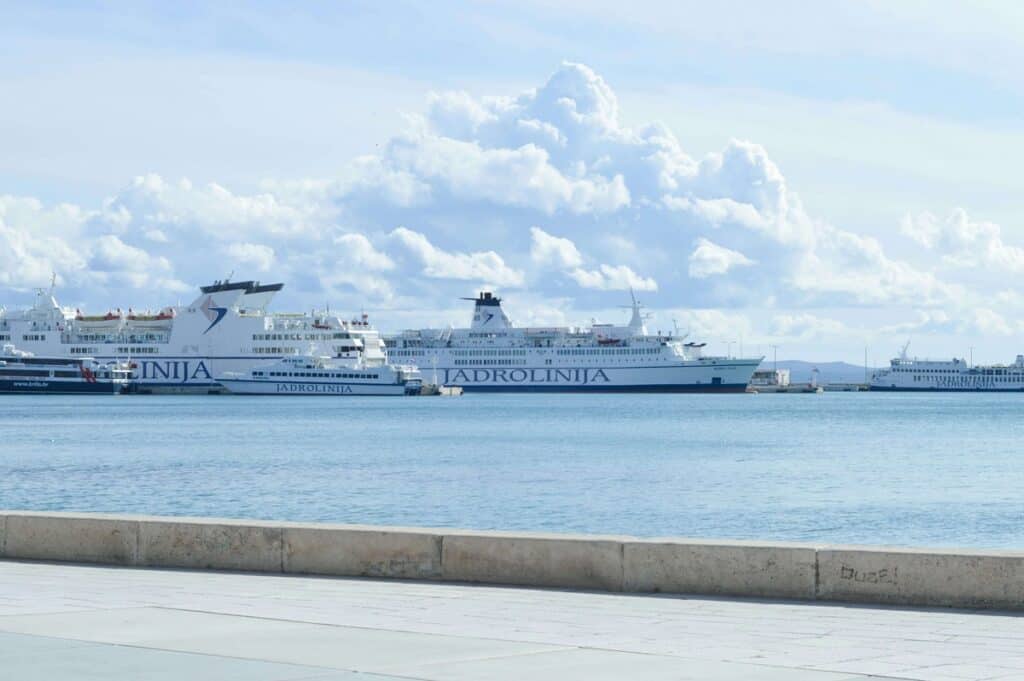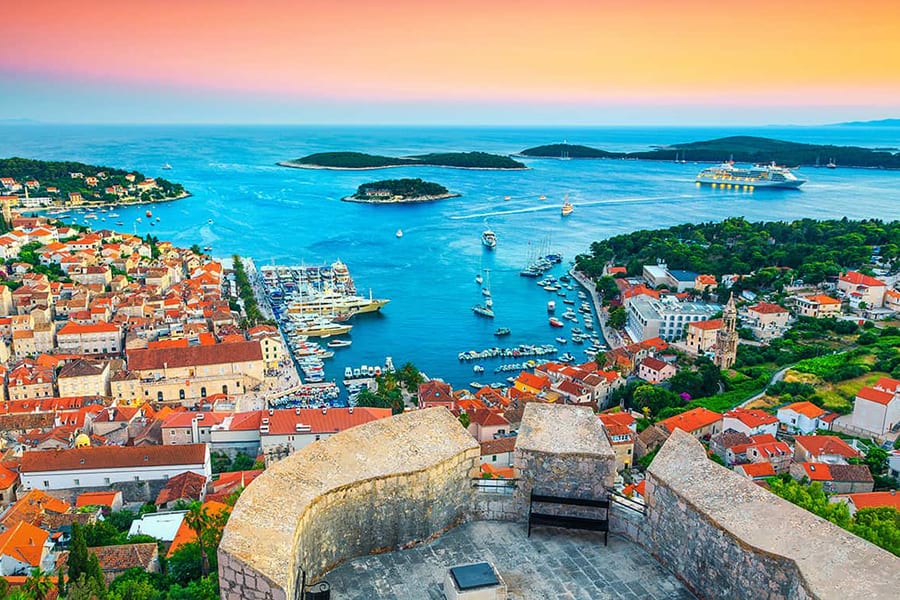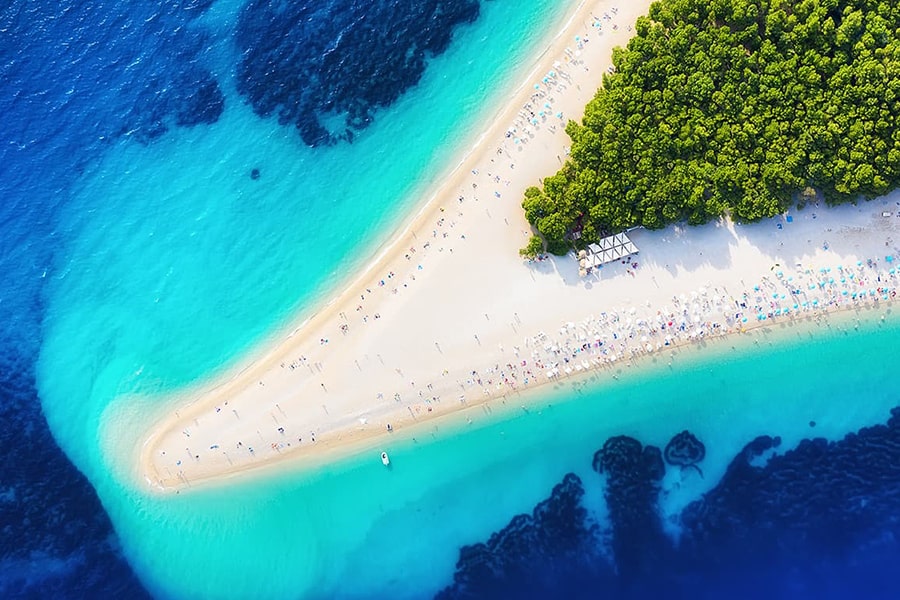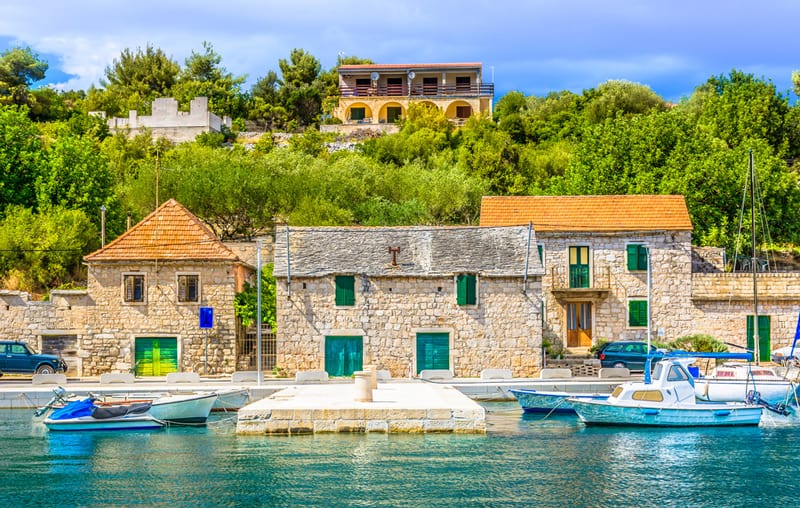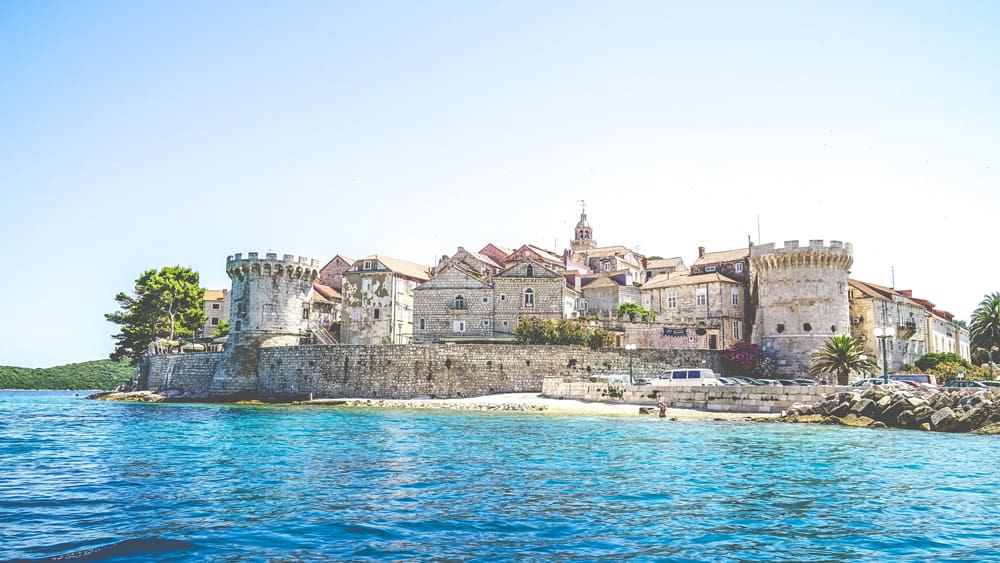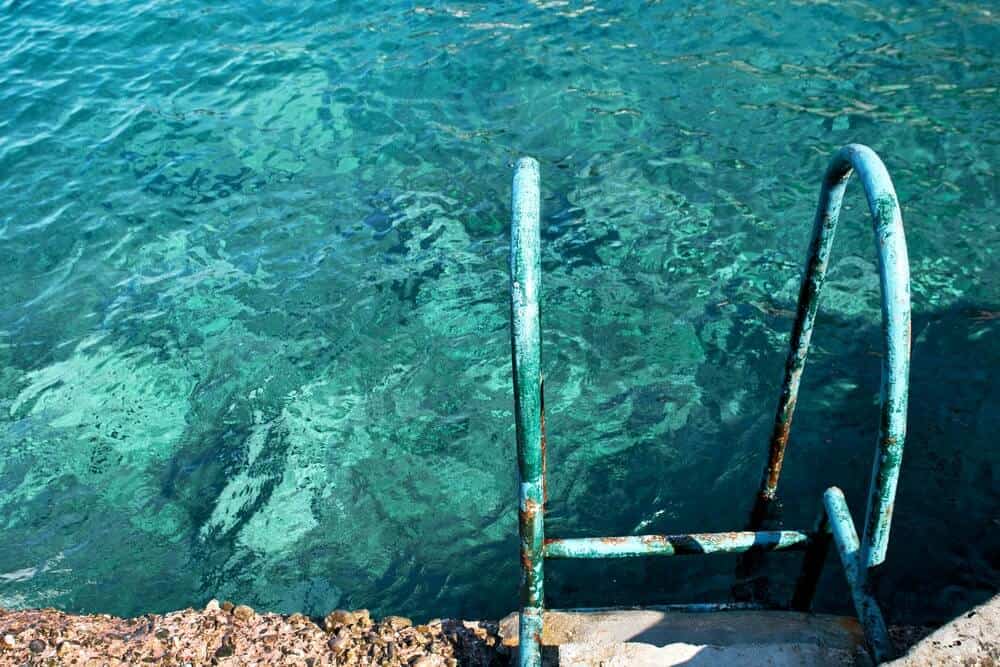Split offers a long list of enticing attractions from Diocletian’s Palace with some of the world’s most well-preserved Roman architecture to beaches framed by turquoise water.
But there are also many islands within easy reach. They can make for an ideal day trip where everything from soaking up the sun on a secluded beach to wine tasting and exploring ancient ruins can be enjoyed.
If you want to make the most of your time, visiting multiple islands from Split by taking our Blue Cave & 5 Islands tour is the best way to do it. It includes visits to popular spots like glamorous Hvar along with hidden gems like the Pakleni islands. But you can also enjoy island hopping from Split on your own by ferry or catamaran, with these some of the top destinations.
Hvar
One of the most popular islands in Croatia, sunny Hvar attracts visitors from across the globe. Spend the day on idyllic beaches like Dubrovica with crystal-clear aquamarine set in a secluded cove.
A Jeep tour can bring you through the countryside to reveal hidden spots among the vineyard-covered hills and fragrant lavender fields. Lavender has been growing here for centuries, used as medicine for over 2,500 years. In June and July, it will be in full bloom, blanketing landscapes with endless purple while the fragrance of the flowers wafts in the salty sea breeze.
A festival celebrates the lavender in mid-July with workshops, demonstrations, and lavender products for sale. You might also visit Stari Grad, the oldest settlement in Croatia, settled in 384 BC, or take a wine tour to taste the island’s wine and learn how it’s made before exploring the delights of Hvar Town.
It’s Hvar Town’s world-class dining and nightlife scene that brings many international jet setters to the island, something you’ll notice with the harbor filled with mega-yachts during the summer.
History buffs can explore landmarks like St. Stephen’s Cathedral built in 1605, Europe’s oldest still operating community theater that welcomed audiences for the first time in 1612, and the hilltop fortress with its tower, bastions, and sturdy walls. From here, you’ll enjoy an awe-inspiring view over the town, harbor, the endless blue of the sea, and the nearby Pakleni islands.
All this, and Hvar can be reached in as little as 50 minutes from Split depending on the specific route and weather conditions.
How to get from Split to Hvar Island (City of Hvar):
During the high season, there are several different island hopping options from Split to Hvar. The catamaran is plausibly the best transportation option for getting from Split to Hvar Island (city of Hvar). There are several companies operating catamaran lines between Split and Hvar, the largest one is “Jadrolinija” which is a government-owned transportation company that operates most of the ferry & catamaran lines between Croatia’s mainland and islands.
Below you can see Jadrolinija’s timetable for the Split to Hvar catamaran route:
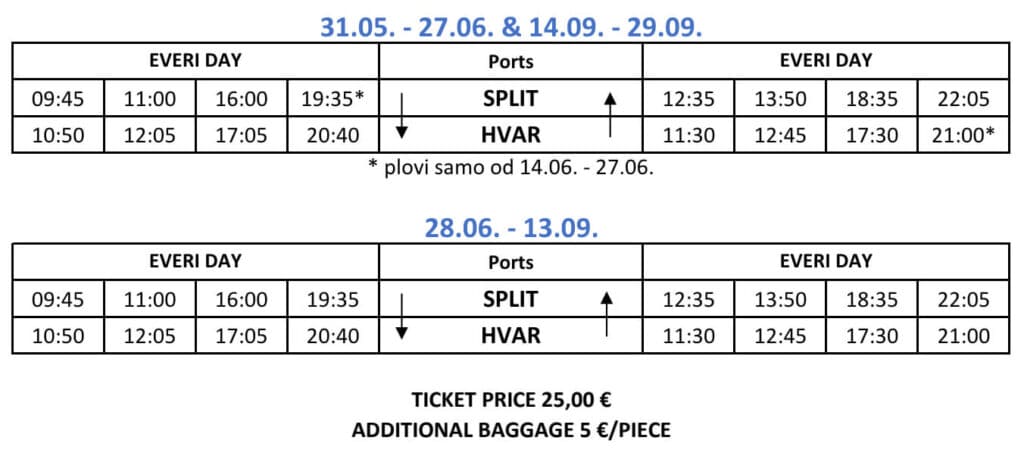
If Jadrolinija’s timetable doesn’t work for you, there are privately owned companies that also operate the Split to Hvar catamaran route. One of them is “Krilo”, and below you can see their timetable for the Split to Hvar catamaran route:

Brac
Brac is less than an hour by ferry from Split while home to one of Europe’s most beautiful beaches: Zlatni Rat. Also known as the Golden Horn for its unique shape, extending about a third of a mile into the sea, it’s surrounded by transparent turquoise water on three sides. It’s an ideal spot for sunbathing, relaxing beneath the pines, swimming, and snorkeling.
Visitors can enjoy plenty of activities on land as well, including hiking and mountain biking. One of the most scenic trails will bring you to the highest point in the Croatian islands, Vidova gora. Your reward for the effort is a panoramic vista of Zlatni Rat and the coast, the sea, and nearby islands.
Brac is not only enticing for nature lovers but also for wine enthusiasts with many family-run wineries. Tastings and tours with the chance to chat with the winemaker are possible too.
In Brac’s oldest village of Skrip, one can visit the Olive Oil Museum to learn about the traditional olive oil-making techniques and view various traditional tools, an olive mill, and an olive press. Samples of olive oil alongside local and regional foods like Brac cheese and Dalmatian prosciutto can be enjoyed as well.
The island is also famous for its limestone that’s shaped its economy and history. The stone quarries here were used to build Diocletian’s Palace in Split, the Parliament House in Budapest, and even the White House in Washington, D.C.
If you have any interest in stonemasonry, visit the Pucisca Stonemasonry School which is open to the public in the summer, with works by the students on display. All in all, Brac is a great island hopping from Split option.
How to get from Split to Brac island:
During the high season, there are several different ferry / catamaran lines operating on Split to/from Brac island route. There are 3 different lines:
- Split (Ferry port) to Brac island (Supetar)
- Split (Ferry port) to Brac island (Milna)
- Split (Ferry port) to Brac island (Bol)
Most likely, Supetar is the destination port you’d want to travel to. Supetar is the largest town on Brac island and it has a lot to offer. But, if you’re planning to visit Zlatni Rat beach, in that case your best option is traveling directly to Bol.

Solta
Solta is just a 30-minute boat ride from Split. In fact, it’s so close that you can see it from the Riva waterfront promenade. Despite its proximity, the island has remained mostly unspoiled with little development as compared to most.
It offers plenty too, including rich history and culture having been inhabited since prehistoric times. There are centuries-old churches, the ancient ruins of sarcophagi, and a crumbling prehistoric fortress. This was one of Roman Emperor Diocletian’s favorite fishing spots and the ruins of his fish market can even be seen beneath the aquamarine-hued water.
Speaking of the underwater world, Solta is a great place for snorkeling with outstanding clarity, and divers can discover plenty at sites like Livka, with one of the most vibrant reefs in this part of the Adriatic. Visitors can also enjoy uncrowded beaches for sunbathing and swimming.
Renting a bike and exploring the island on two wheels is always enjoyable but you’ll also want to walk around Grohote. The largest, oldest, and most important settlement throughout history, it sits at the heart of the island, about a mile from the main port.
You’ll notice architecture from the Roman era, though the village is dominated by the Neo-Renaissance Church of St. Stephen. You’ll also see the tower of a 16th-century castle built by a noble family from Split.
Solta is a gem for foodies and wine lovers, notable for multiple products, including honey, olive oil, and wine. Tours are available that will bring you to learn about the island’s olive oil-making traditions while exploring an olive mill.
It’s even possible to learn how to make honey with a visit to a family-run farm in Grohote. The Tvrdic family has been beekeeping and making honey here for three generations and offers tours and the chance to learn more about authentic farm living.
Korcula
It takes a little longer to get to Korcula from Split, with a ferry time that ranges from two hours and 20 minutes to three hours and 40 minutes depending on the route and conditions, but the effort is worth the reward.
One of the most enchanting islands in Croatia, it was named Melaina Korkyra, or “Black Corfu” by early Greek settlers as it appeared almost black from a distance due to the dense, pine forests. It’s also home to picture-perfect beaches and vineyard-covered landscapes, but the top attraction is arguably Old Town Korcula.
The historical center looks as if it came straight from the pages of a storybook. Sometimes referred to as a “mini-Dubrovnik,” it’s surrounded by medieval stone walls, imposing gates, and towers.
Inside is a labyrinth of narrow cobbled streets and alleyways with buildings exhibiting lots of Venetian influence. That includes St. Mark’s Cathedral with its pair of winged lions. Opened in 1407, the Gothic-Renaissance building includes a bell tower that can be climbed for a panoramic view.
Learn more about Korcula’s history at the Korcula Town Museum, set in a 16th-century palace. Highlights include fine examples of traditional dress, archaeological exhibits, and a tablet recording Greek presence on the island in the 3rd century BC.
No matter when you visit, you’ll find delicious authentic cuisine in the traditional konobas, but if you’re here in the summer, you can catch one of the regularly held Moreska sword dance performances.
Of course, you can always spend a day at the beach. The southern part of the island is home to mostly sandy stretches, frequently nestled in secluded bays.
Vela Przina is often noted among the most beautiful, hidden behind vineyards near the village of Lumbarda just a short drive south of Old Town Korcula. The shallow turquoise water is ideal for swimming and paddling, and there are a couple of eateries on the beach too.
Lastovo
Facing Korcula Island, Lastovo is a true hidden gem, 65 nautical miles from Split with the fastest ferry taking three hours and 15 minutes. Once there you’ll enjoy one of the most tranquil islands in Dalmatia, with about 70 percent covered by forest.
There are scenic hiking and cycling trails, with bike rentals available in Pasadur, and two diving centers, one in Zaklopatica and one in Pasadur, along with small, crystal-clear blue bays home to vibrant coral and colorful fish.
Lastovo is home to six villages in total, including Lastovo, the main village. It’s tucked onto a steep slope overlooking fields with olive groves and grape vines, enjoyable just to wander around with old stone homes and their iconic red roofs, and historic churches.
There are nearly four dozen churches on the island dating between the 12th and 15th centuries, with the main church of St. Kuzma and Damian at least 700 years old. Lastovo may best be known for its carnival, however. It commemorates the victory over the pirates, Lastovski Poklad, with all residents participating by wearing folk costumes.
Vis
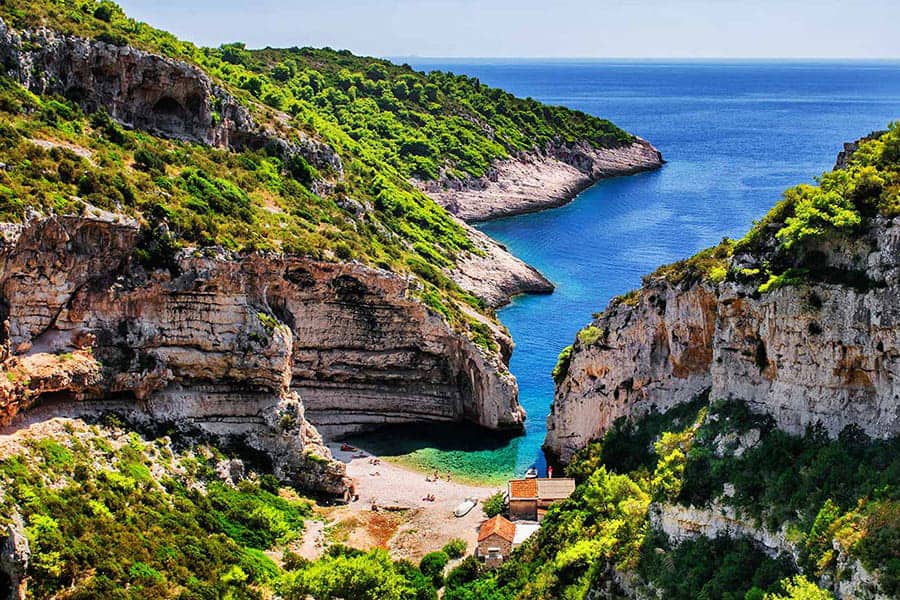
Vis is one of the furthest inhabited islands from Split, but a direct ferry can bring you to this unspoiled paradise in just an hour and 20 minutes. Its more remote location and use as a military base for 40 years prevented much tourist development, allowing visitors to enjoy what’s often referred to as the “Mediterranean as it once was.”
You won’t see any cheap souvenir stalls here but you will find beautiful beaches like Stiniva, tucked into a secluded cove framed by brilliant blue-green water. Ideal for a refreshing dip, sometimes you’ll find yourself swimming alongside a dolphin or loggerhead turtle.
There’s lots of history to explore too, from Roman ruins and Venetian architecture to relics from the Croatian War of Independence. Tito’s Cave serves as a testament to the Yugoslav Partisan resistance, serving as a secret meeting place for Josip Broz Tito, the former President of the Socialist Federal Republic of Yugoslavia and his comrades.
In Vis Town, explore the City Museum housed in a 19th-century fortress. It showcases an impressive collection of artifacts, including a bronze head of the goddess Artemis that dates from the 4th century BC. Set on a hilltop overlooking the town, Fort George is also a great spot for a panoramic view, with a restaurant where you can sip a glass of wine while watching a colorful sunset.
One of the top things to do while on Vis is to take the Blue Cave tour. You can visit as part of our Blue Cave & 5 Islands tour but if you’re already on Vis, there are also boat departures from Komiza port.
They’ll bring you to marvel at the cave’s interior, illuminated with a surreal, brilliant blue glow. The remarkable phenomenon occurs when the sun beams through a crack in the cave’s roof, reflecting on the white limestone sea bottom.
Island Hopping From Split Summarised
Split is more than just a gateway to some of Croatia’s most captivating islands; it’s a treasure trove of history, culture, and natural beauty. Whether you are exploring the ancient ruins of Diocletian’s Palace or embarking on an island-hopping adventure, there is something for everyone.
Each island offers its unique charm, from Hvar’s vibrant nightlife and historical sites to Brac’s stunning Zlatni Rat beach and wine tours. Solta’s unspoiled beauty, Korcula’s enchanting old town, Lastovo’s tranquil forests, and Vis’s untouched paradise all promise unforgettable experiences.
By taking advantage of the convenient ferry and catamaran routes from Split, visitors can easily explore these diverse islands, each offering a distinct slice of Croatian culture and natural beauty.
Whether you prefer guided tours like the Blue Cave & 5 Islands tour or wish to venture out on your own, the islands near Split are sure to leave you with lasting memories and a desire to return. Embrace the adventure, soak in the history, and enjoy the breathtaking landscapes of this stunning region.

